Operation Comparison: Starbucks vs. Greggs - Business Strategy Report
VerifiedAdded on 2022/08/23
|8
|2053
|37
Report
AI Summary
This report provides a comparative analysis of the operational strategies of Starbucks and Greggs, examining their approaches through the lens of the Four Vs (Volume, Variety, Variation, Visibility) framework. It delves into the performance objectives of each company, including speed, quality, dependability, flexibility, and cost, highlighting the differences in their strategic goals and implementation. The report also analyzes the store designs of Starbucks and Greggs, considering how these designs reflect their respective corporate strategies and target audiences. Furthermore, it explores the different approaches to management, like perspective and emergent approaches, and organizational goals, offering a comprehensive overview of how these companies manage their operations to achieve their business objectives. The report concludes by emphasizing the unique cultural values that contribute to the success of each company, such as employee recognition programs.
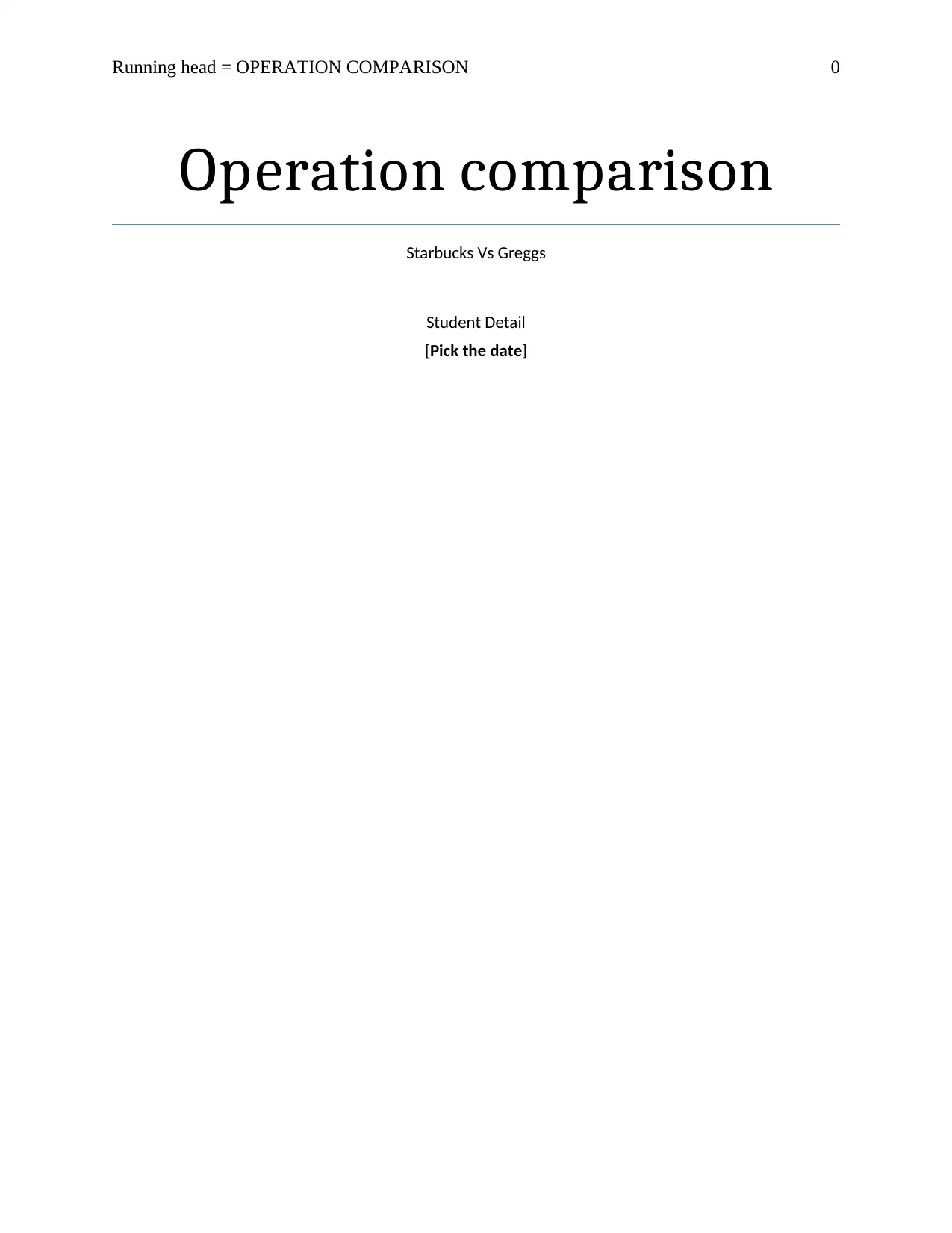
Running head = OPERATION COMPARISON 0
Operation comparison
Starbucks Vs Greggs
Student Detail
[Pick the date]
Operation comparison
Starbucks Vs Greggs
Student Detail
[Pick the date]
Paraphrase This Document
Need a fresh take? Get an instant paraphrase of this document with our AI Paraphraser
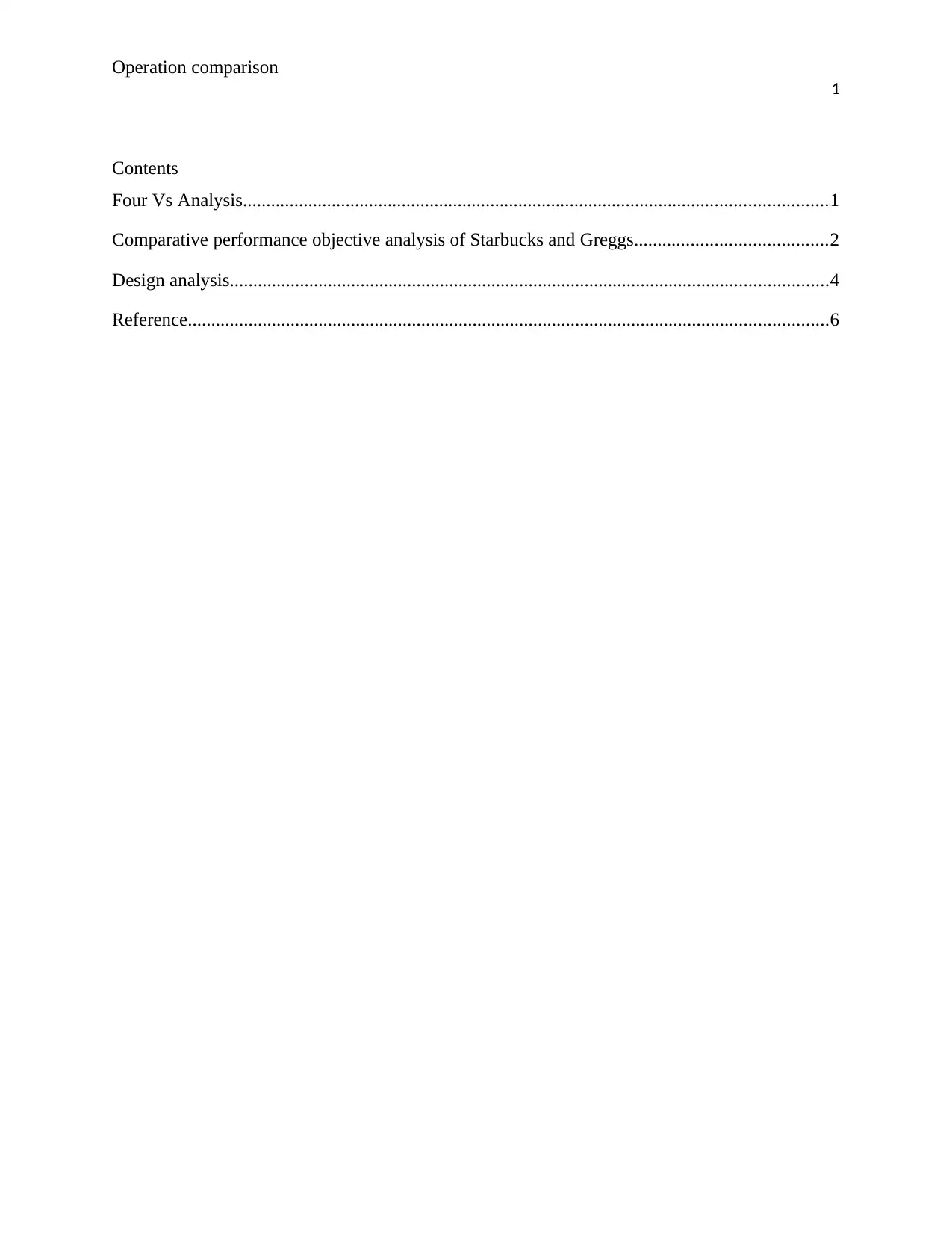
Operation comparison
1
Contents
Four Vs Analysis.............................................................................................................................1
Comparative performance objective analysis of Starbucks and Greggs.........................................2
Design analysis................................................................................................................................4
Reference.........................................................................................................................................6
1
Contents
Four Vs Analysis.............................................................................................................................1
Comparative performance objective analysis of Starbucks and Greggs.........................................2
Design analysis................................................................................................................................4
Reference.........................................................................................................................................6
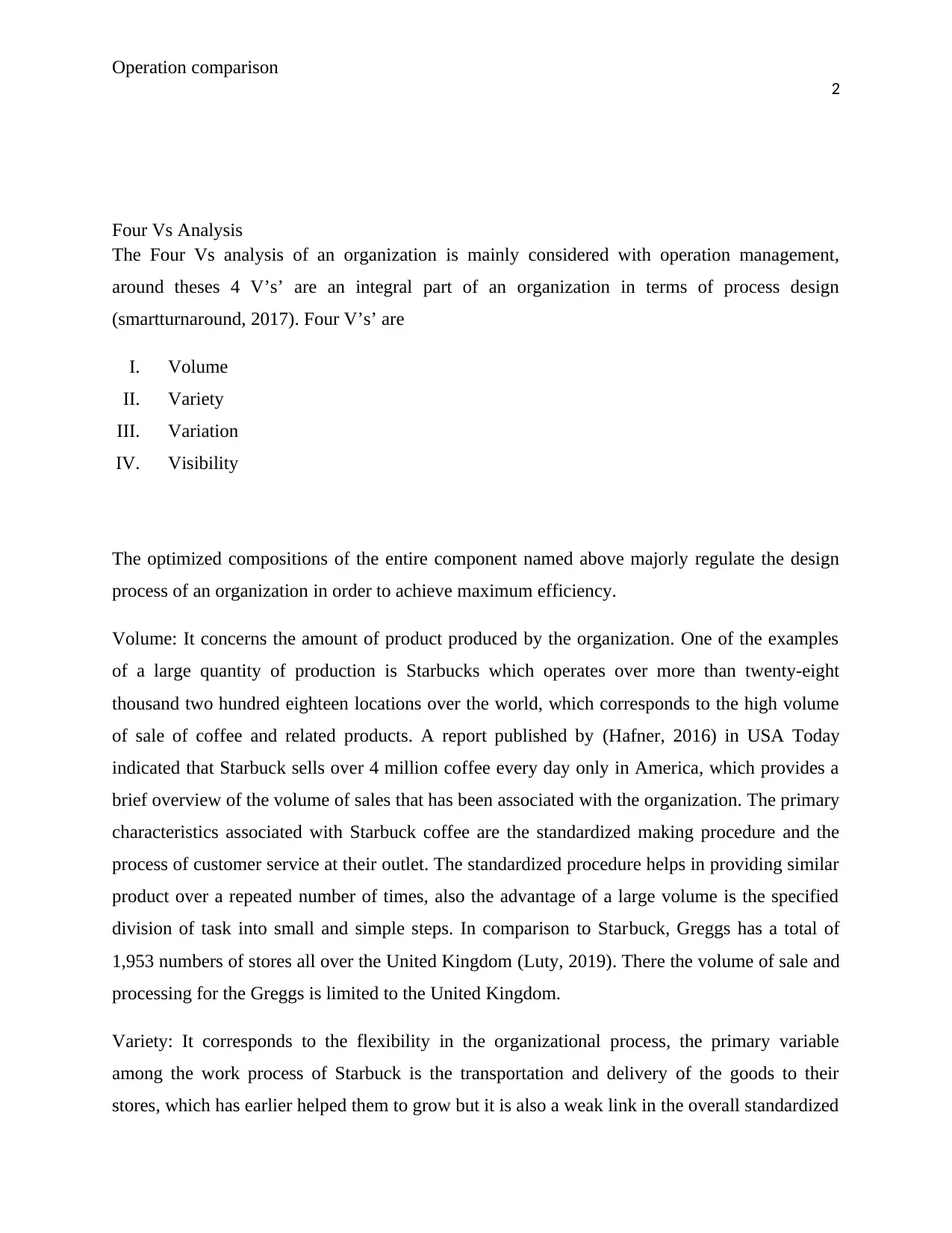
Operation comparison
2
Four Vs Analysis
The Four Vs analysis of an organization is mainly considered with operation management,
around theses 4 V’s’ are an integral part of an organization in terms of process design
(smartturnaround, 2017). Four V’s’ are
I. Volume
II. Variety
III. Variation
IV. Visibility
The optimized compositions of the entire component named above majorly regulate the design
process of an organization in order to achieve maximum efficiency.
Volume: It concerns the amount of product produced by the organization. One of the examples
of a large quantity of production is Starbucks which operates over more than twenty-eight
thousand two hundred eighteen locations over the world, which corresponds to the high volume
of sale of coffee and related products. A report published by (Hafner, 2016) in USA Today
indicated that Starbuck sells over 4 million coffee every day only in America, which provides a
brief overview of the volume of sales that has been associated with the organization. The primary
characteristics associated with Starbuck coffee are the standardized making procedure and the
process of customer service at their outlet. The standardized procedure helps in providing similar
product over a repeated number of times, also the advantage of a large volume is the specified
division of task into small and simple steps. In comparison to Starbuck, Greggs has a total of
1,953 numbers of stores all over the United Kingdom (Luty, 2019). There the volume of sale and
processing for the Greggs is limited to the United Kingdom.
Variety: It corresponds to the flexibility in the organizational process, the primary variable
among the work process of Starbuck is the transportation and delivery of the goods to their
stores, which has earlier helped them to grow but it is also a weak link in the overall standardized
2
Four Vs Analysis
The Four Vs analysis of an organization is mainly considered with operation management,
around theses 4 V’s’ are an integral part of an organization in terms of process design
(smartturnaround, 2017). Four V’s’ are
I. Volume
II. Variety
III. Variation
IV. Visibility
The optimized compositions of the entire component named above majorly regulate the design
process of an organization in order to achieve maximum efficiency.
Volume: It concerns the amount of product produced by the organization. One of the examples
of a large quantity of production is Starbucks which operates over more than twenty-eight
thousand two hundred eighteen locations over the world, which corresponds to the high volume
of sale of coffee and related products. A report published by (Hafner, 2016) in USA Today
indicated that Starbuck sells over 4 million coffee every day only in America, which provides a
brief overview of the volume of sales that has been associated with the organization. The primary
characteristics associated with Starbuck coffee are the standardized making procedure and the
process of customer service at their outlet. The standardized procedure helps in providing similar
product over a repeated number of times, also the advantage of a large volume is the specified
division of task into small and simple steps. In comparison to Starbuck, Greggs has a total of
1,953 numbers of stores all over the United Kingdom (Luty, 2019). There the volume of sale and
processing for the Greggs is limited to the United Kingdom.
Variety: It corresponds to the flexibility in the organizational process, the primary variable
among the work process of Starbuck is the transportation and delivery of the goods to their
stores, which has earlier helped them to grow but it is also a weak link in the overall standardized
⊘ This is a preview!⊘
Do you want full access?
Subscribe today to unlock all pages.

Trusted by 1+ million students worldwide
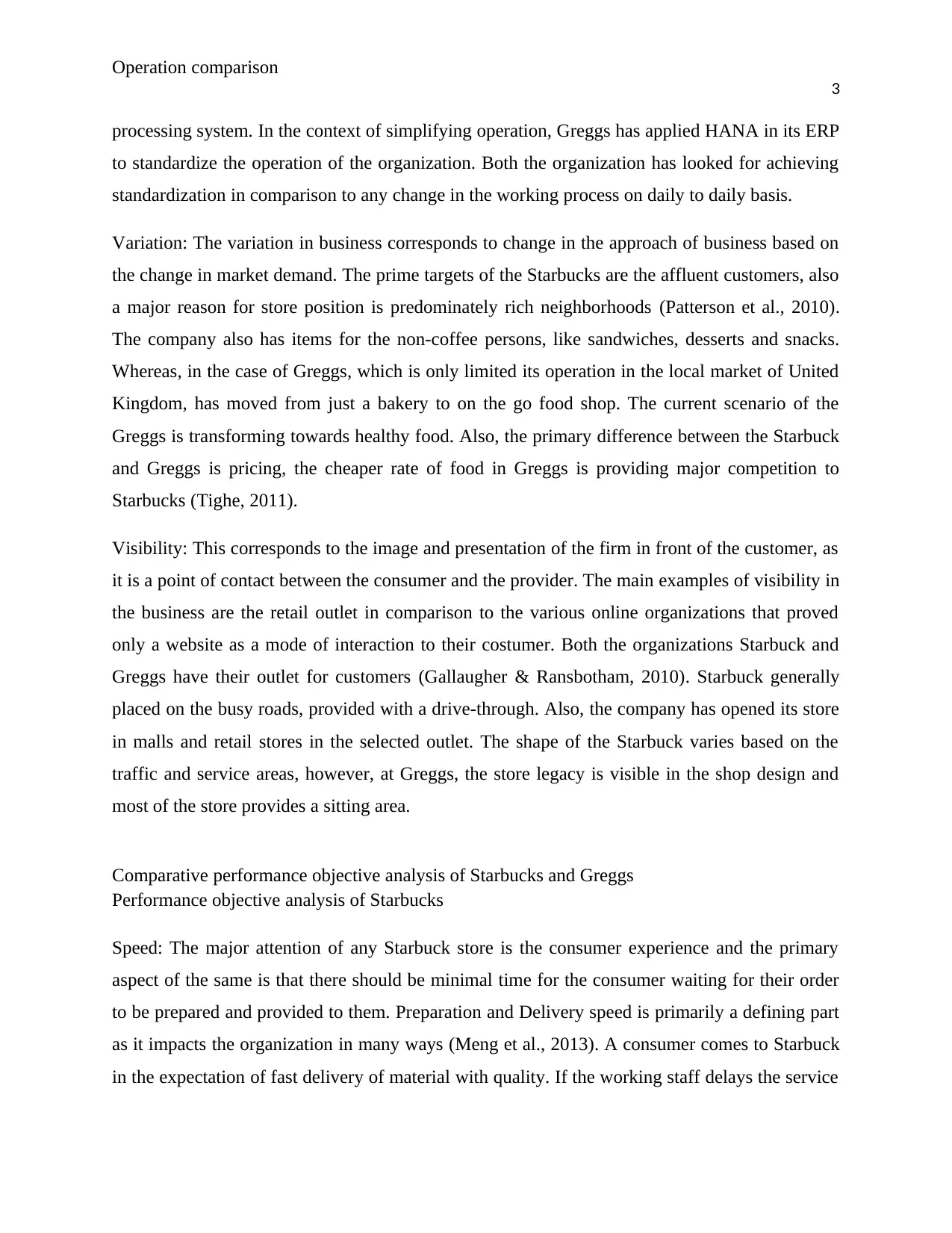
Operation comparison
3
processing system. In the context of simplifying operation, Greggs has applied HANA in its ERP
to standardize the operation of the organization. Both the organization has looked for achieving
standardization in comparison to any change in the working process on daily to daily basis.
Variation: The variation in business corresponds to change in the approach of business based on
the change in market demand. The prime targets of the Starbucks are the affluent customers, also
a major reason for store position is predominately rich neighborhoods (Patterson et al., 2010).
The company also has items for the non-coffee persons, like sandwiches, desserts and snacks.
Whereas, in the case of Greggs, which is only limited its operation in the local market of United
Kingdom, has moved from just a bakery to on the go food shop. The current scenario of the
Greggs is transforming towards healthy food. Also, the primary difference between the Starbuck
and Greggs is pricing, the cheaper rate of food in Greggs is providing major competition to
Starbucks (Tighe, 2011).
Visibility: This corresponds to the image and presentation of the firm in front of the customer, as
it is a point of contact between the consumer and the provider. The main examples of visibility in
the business are the retail outlet in comparison to the various online organizations that proved
only a website as a mode of interaction to their costumer. Both the organizations Starbuck and
Greggs have their outlet for customers (Gallaugher & Ransbotham, 2010). Starbuck generally
placed on the busy roads, provided with a drive-through. Also, the company has opened its store
in malls and retail stores in the selected outlet. The shape of the Starbuck varies based on the
traffic and service areas, however, at Greggs, the store legacy is visible in the shop design and
most of the store provides a sitting area.
Comparative performance objective analysis of Starbucks and Greggs
Performance objective analysis of Starbucks
Speed: The major attention of any Starbuck store is the consumer experience and the primary
aspect of the same is that there should be minimal time for the consumer waiting for their order
to be prepared and provided to them. Preparation and Delivery speed is primarily a defining part
as it impacts the organization in many ways (Meng et al., 2013). A consumer comes to Starbuck
in the expectation of fast delivery of material with quality. If the working staff delays the service
3
processing system. In the context of simplifying operation, Greggs has applied HANA in its ERP
to standardize the operation of the organization. Both the organization has looked for achieving
standardization in comparison to any change in the working process on daily to daily basis.
Variation: The variation in business corresponds to change in the approach of business based on
the change in market demand. The prime targets of the Starbucks are the affluent customers, also
a major reason for store position is predominately rich neighborhoods (Patterson et al., 2010).
The company also has items for the non-coffee persons, like sandwiches, desserts and snacks.
Whereas, in the case of Greggs, which is only limited its operation in the local market of United
Kingdom, has moved from just a bakery to on the go food shop. The current scenario of the
Greggs is transforming towards healthy food. Also, the primary difference between the Starbuck
and Greggs is pricing, the cheaper rate of food in Greggs is providing major competition to
Starbucks (Tighe, 2011).
Visibility: This corresponds to the image and presentation of the firm in front of the customer, as
it is a point of contact between the consumer and the provider. The main examples of visibility in
the business are the retail outlet in comparison to the various online organizations that proved
only a website as a mode of interaction to their costumer. Both the organizations Starbuck and
Greggs have their outlet for customers (Gallaugher & Ransbotham, 2010). Starbuck generally
placed on the busy roads, provided with a drive-through. Also, the company has opened its store
in malls and retail stores in the selected outlet. The shape of the Starbuck varies based on the
traffic and service areas, however, at Greggs, the store legacy is visible in the shop design and
most of the store provides a sitting area.
Comparative performance objective analysis of Starbucks and Greggs
Performance objective analysis of Starbucks
Speed: The major attention of any Starbuck store is the consumer experience and the primary
aspect of the same is that there should be minimal time for the consumer waiting for their order
to be prepared and provided to them. Preparation and Delivery speed is primarily a defining part
as it impacts the organization in many ways (Meng et al., 2013). A consumer comes to Starbuck
in the expectation of fast delivery of material with quality. If the working staff delays the service
Paraphrase This Document
Need a fresh take? Get an instant paraphrase of this document with our AI Paraphraser

Operation comparison
4
due to lack of proper knowledge of the working protocol or lack of training, this could lead to
consumer dissatisfaction, also the delay in service could affect the quality of food and beverage.
Quality: The primary objective of performance management is to provide good quality of
products repeatedly without any deviation, also this is the ultimate selling point for the
organization along with it is the defining separation factor for the organization that separates it
from other organizations (Evans, 2013). The quality of the product is also a very important
aspect of consumer satisfaction. The quality of the product is depended on the staff as well as
consumer perception about the product taste. The quality of the product is also affected by the
source along with the time taken for the preparation of food and beverage.
Dependability: The consistency in the performance of the organization is also very important,
which can be estimated on the basis of feedback provided by the consumers in terms of food and
service quality.
Flexibility: The change in the demographic of the business requires both speed and flexibility.
The faster speed of operation provides an opportunity to quickly adjust the process as per the
demand of the market. The flexibility also includes the ability to accommodate the need of the
customer based on the changing requirement (Schultz, 2012) (Wright & Simmons, 2015).
Cost: It is one of the major driving factors as all the organization working in any sector always
have a profit margin that they want to maximize, the primary expenditure cost for Starbucks is its
procurement of coffee and the transportation used for the supply of their products to their stores.
The organization has tried to reduce the procurement cost of the coffee bean by growing
themselves.
The performance objective at the Greggs is entirely different from the Starbucks, in terms of the
flexibility in the approaches. Greggs have applied both perspective and emergent theories at their
workplace. The perspective approach deals with the organization's design, strategy and
objectives decided by the executives based on the analysis of the market and future trends of the
market. The emergent approach contradicts the previously mentioned approach adopted by
Greggs as it helps managers at different levels to change their strategy in a local market, along
with their say in the objectives. The application of perspective and emergent approach is that the
4
due to lack of proper knowledge of the working protocol or lack of training, this could lead to
consumer dissatisfaction, also the delay in service could affect the quality of food and beverage.
Quality: The primary objective of performance management is to provide good quality of
products repeatedly without any deviation, also this is the ultimate selling point for the
organization along with it is the defining separation factor for the organization that separates it
from other organizations (Evans, 2013). The quality of the product is also a very important
aspect of consumer satisfaction. The quality of the product is depended on the staff as well as
consumer perception about the product taste. The quality of the product is also affected by the
source along with the time taken for the preparation of food and beverage.
Dependability: The consistency in the performance of the organization is also very important,
which can be estimated on the basis of feedback provided by the consumers in terms of food and
service quality.
Flexibility: The change in the demographic of the business requires both speed and flexibility.
The faster speed of operation provides an opportunity to quickly adjust the process as per the
demand of the market. The flexibility also includes the ability to accommodate the need of the
customer based on the changing requirement (Schultz, 2012) (Wright & Simmons, 2015).
Cost: It is one of the major driving factors as all the organization working in any sector always
have a profit margin that they want to maximize, the primary expenditure cost for Starbucks is its
procurement of coffee and the transportation used for the supply of their products to their stores.
The organization has tried to reduce the procurement cost of the coffee bean by growing
themselves.
The performance objective at the Greggs is entirely different from the Starbucks, in terms of the
flexibility in the approaches. Greggs have applied both perspective and emergent theories at their
workplace. The perspective approach deals with the organization's design, strategy and
objectives decided by the executives based on the analysis of the market and future trends of the
market. The emergent approach contradicts the previously mentioned approach adopted by
Greggs as it helps managers at different levels to change their strategy in a local market, along
with their say in the objectives. The application of perspective and emergent approach is that the

Operation comparison
5
former helps in analyzing the market situation and the latter helps in gathering ground level
information and competitive advantage. The emergent approach of Greggs is one of the major
differences between Greggs and Starbuck, as Starbucks majorly follows perspective approach.
The three major types of goals which comprise of Greggs organizational goals are:
Strategic: This goal helps the organization in determining its future trends are the target
organization wants to achieve in terms of market position.
Tactical: It corresponds to the important area of the organization and the targets are highly
concentrated on these departments.
Organizational: The results that are expected from certain departments, groups, and individuals.
Every organization has own set of values, which helps in providing a framework to the
organization in terms of working culture and working environment.
Design analysis
A typical Starbucks store is designed based on its corporate strategy and standardized protocol
based on the location of the store, to provide the consumer with a good experience over coffee
and eatables. The emphasis of the store is to make it more environments friendly. Therefore the
design and construction of the store in terms of landscape, the material used and lighting are used
for a sustainable environment, which is further guided by the four Vs of the company too.
However, with the increased number of stores and diversified geographical location the
performance objective analysis, takes over the store design. As most of the Starbuck store
provide drive-through service, speed is more essential than the design of the inner area.
Therefore store design is optimized for the minimum time consumption at the time of delivery of
the goods to the consumers. The unique culture value in the store to enhance the performance of
the employee to achieve the objective of the organization is one of the primary reasons for the
success of Starbucks. The concept of calling employees as the partner and rewarding its
employee for their achievements has helped the organization in achieving more consumer
satisfaction. The stores of Greggs are continually transitioning as the company is going from a
simple baker store to fully develop on the go food stores. In the one of the recent stores named
“Greggs The Bakery” provides an alternative of 75 new products to comply with its 4 Vs of the
5
former helps in analyzing the market situation and the latter helps in gathering ground level
information and competitive advantage. The emergent approach of Greggs is one of the major
differences between Greggs and Starbuck, as Starbucks majorly follows perspective approach.
The three major types of goals which comprise of Greggs organizational goals are:
Strategic: This goal helps the organization in determining its future trends are the target
organization wants to achieve in terms of market position.
Tactical: It corresponds to the important area of the organization and the targets are highly
concentrated on these departments.
Organizational: The results that are expected from certain departments, groups, and individuals.
Every organization has own set of values, which helps in providing a framework to the
organization in terms of working culture and working environment.
Design analysis
A typical Starbucks store is designed based on its corporate strategy and standardized protocol
based on the location of the store, to provide the consumer with a good experience over coffee
and eatables. The emphasis of the store is to make it more environments friendly. Therefore the
design and construction of the store in terms of landscape, the material used and lighting are used
for a sustainable environment, which is further guided by the four Vs of the company too.
However, with the increased number of stores and diversified geographical location the
performance objective analysis, takes over the store design. As most of the Starbuck store
provide drive-through service, speed is more essential than the design of the inner area.
Therefore store design is optimized for the minimum time consumption at the time of delivery of
the goods to the consumers. The unique culture value in the store to enhance the performance of
the employee to achieve the objective of the organization is one of the primary reasons for the
success of Starbucks. The concept of calling employees as the partner and rewarding its
employee for their achievements has helped the organization in achieving more consumer
satisfaction. The stores of Greggs are continually transitioning as the company is going from a
simple baker store to fully develop on the go food stores. In the one of the recent stores named
“Greggs The Bakery” provides an alternative of 75 new products to comply with its 4 Vs of the
⊘ This is a preview!⊘
Do you want full access?
Subscribe today to unlock all pages.

Trusted by 1+ million students worldwide
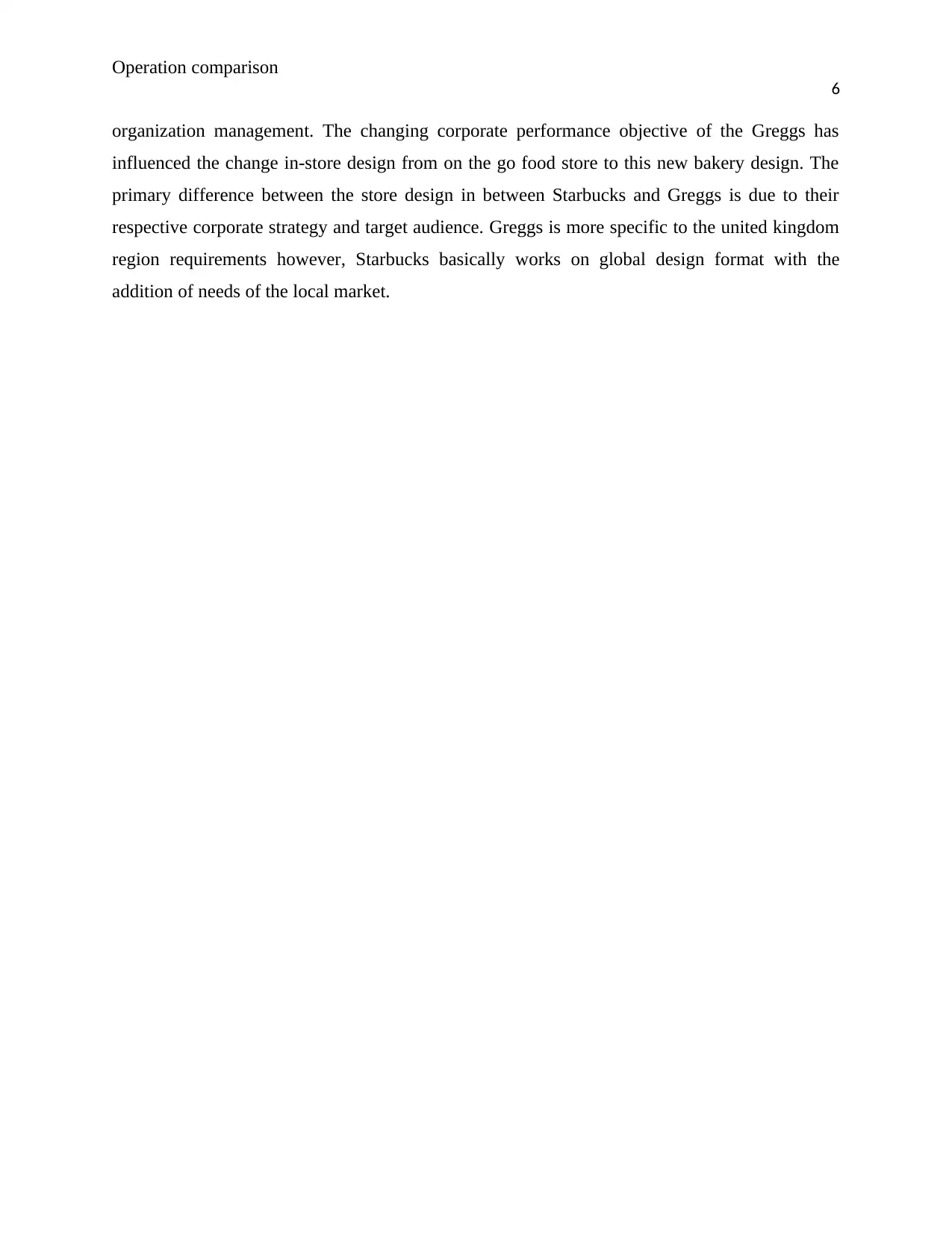
Operation comparison
6
organization management. The changing corporate performance objective of the Greggs has
influenced the change in-store design from on the go food store to this new bakery design. The
primary difference between the store design in between Starbucks and Greggs is due to their
respective corporate strategy and target audience. Greggs is more specific to the united kingdom
region requirements however, Starbucks basically works on global design format with the
addition of needs of the local market.
6
organization management. The changing corporate performance objective of the Greggs has
influenced the change in-store design from on the go food store to this new bakery design. The
primary difference between the store design in between Starbucks and Greggs is due to their
respective corporate strategy and target audience. Greggs is more specific to the united kingdom
region requirements however, Starbucks basically works on global design format with the
addition of needs of the local market.
Paraphrase This Document
Need a fresh take? Get an instant paraphrase of this document with our AI Paraphraser
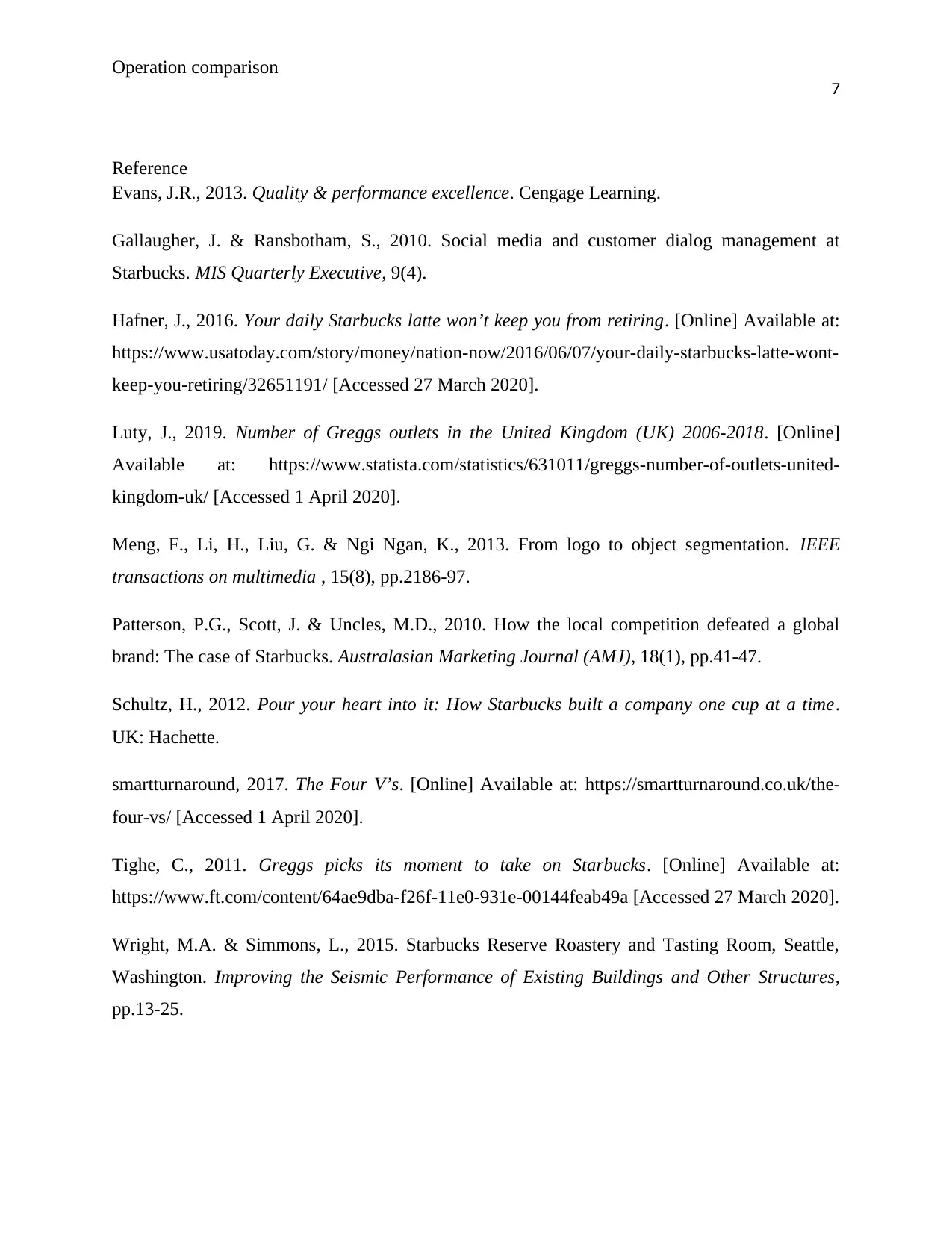
Operation comparison
7
Reference
Evans, J.R., 2013. Quality & performance excellence. Cengage Learning.
Gallaugher, J. & Ransbotham, S., 2010. Social media and customer dialog management at
Starbucks. MIS Quarterly Executive, 9(4).
Hafner, J., 2016. Your daily Starbucks latte won’t keep you from retiring. [Online] Available at:
https://www.usatoday.com/story/money/nation-now/2016/06/07/your-daily-starbucks-latte-wont-
keep-you-retiring/32651191/ [Accessed 27 March 2020].
Luty, J., 2019. Number of Greggs outlets in the United Kingdom (UK) 2006-2018. [Online]
Available at: https://www.statista.com/statistics/631011/greggs-number-of-outlets-united-
kingdom-uk/ [Accessed 1 April 2020].
Meng, F., Li, H., Liu, G. & Ngi Ngan, K., 2013. From logo to object segmentation. IEEE
transactions on multimedia , 15(8), pp.2186-97.
Patterson, P.G., Scott, J. & Uncles, M.D., 2010. How the local competition defeated a global
brand: The case of Starbucks. Australasian Marketing Journal (AMJ), 18(1), pp.41-47.
Schultz, H., 2012. Pour your heart into it: How Starbucks built a company one cup at a time.
UK: Hachette.
smartturnaround, 2017. The Four V’s. [Online] Available at: https://smartturnaround.co.uk/the-
four-vs/ [Accessed 1 April 2020].
Tighe, C., 2011. Greggs picks its moment to take on Starbucks. [Online] Available at:
https://www.ft.com/content/64ae9dba-f26f-11e0-931e-00144feab49a [Accessed 27 March 2020].
Wright, M.A. & Simmons, L., 2015. Starbucks Reserve Roastery and Tasting Room, Seattle,
Washington. Improving the Seismic Performance of Existing Buildings and Other Structures,
pp.13-25.
7
Reference
Evans, J.R., 2013. Quality & performance excellence. Cengage Learning.
Gallaugher, J. & Ransbotham, S., 2010. Social media and customer dialog management at
Starbucks. MIS Quarterly Executive, 9(4).
Hafner, J., 2016. Your daily Starbucks latte won’t keep you from retiring. [Online] Available at:
https://www.usatoday.com/story/money/nation-now/2016/06/07/your-daily-starbucks-latte-wont-
keep-you-retiring/32651191/ [Accessed 27 March 2020].
Luty, J., 2019. Number of Greggs outlets in the United Kingdom (UK) 2006-2018. [Online]
Available at: https://www.statista.com/statistics/631011/greggs-number-of-outlets-united-
kingdom-uk/ [Accessed 1 April 2020].
Meng, F., Li, H., Liu, G. & Ngi Ngan, K., 2013. From logo to object segmentation. IEEE
transactions on multimedia , 15(8), pp.2186-97.
Patterson, P.G., Scott, J. & Uncles, M.D., 2010. How the local competition defeated a global
brand: The case of Starbucks. Australasian Marketing Journal (AMJ), 18(1), pp.41-47.
Schultz, H., 2012. Pour your heart into it: How Starbucks built a company one cup at a time.
UK: Hachette.
smartturnaround, 2017. The Four V’s. [Online] Available at: https://smartturnaround.co.uk/the-
four-vs/ [Accessed 1 April 2020].
Tighe, C., 2011. Greggs picks its moment to take on Starbucks. [Online] Available at:
https://www.ft.com/content/64ae9dba-f26f-11e0-931e-00144feab49a [Accessed 27 March 2020].
Wright, M.A. & Simmons, L., 2015. Starbucks Reserve Roastery and Tasting Room, Seattle,
Washington. Improving the Seismic Performance of Existing Buildings and Other Structures,
pp.13-25.
1 out of 8
Related Documents
Your All-in-One AI-Powered Toolkit for Academic Success.
+13062052269
info@desklib.com
Available 24*7 on WhatsApp / Email
![[object Object]](/_next/static/media/star-bottom.7253800d.svg)
Unlock your academic potential
Copyright © 2020–2025 A2Z Services. All Rights Reserved. Developed and managed by ZUCOL.





